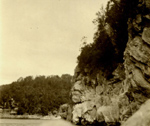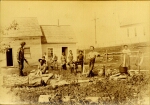
Koluskap
The Wolastoqew storytelling tradition is as ancient as the time winter has been. For it was only then, when so much time was spent in wigwams, that the stories spilled from the lips of the No-dji-tak-win—the singer. Once asked of a Wolastoqew man, “Can you speak your mother tongue?” He replied, “No, but I can sing it.” It has been claimed repeatedly that the euphonious quality of the language makes it one of the most beautiful to hear. Nowhere is this more evident than when elders bare their true feelings and beliefs through narratives of social origin, geography, real life and how things are done in both practical and unexplainable modes.
.jpg)
Abner Paul, Talking stick, c. 1977
Set in real surroundings, both natural and mysterious qualities of animals, humans and super humans are presented in complex plots of personal power and survival that focus on the dynamics of getting along. Often the life lesson with its profound human wisdom is taught through intricate story cycles featuring the Wabanaki cultural champion, Koluskap. In these stories, the actions move about from conscious to sub-conscious, from logical explanations to dreamlike happenings. Characters abound everywhere with their shapes shifting between human and animal forms and back again, illustrating the close bonds among all living beings. From the lowly clam spy to the tiny Mikumwes who flies and never lies; from lazy Uncle Turtle to the busybody Grandmother Groundhog and many more, all express, through the stories, everything about living.
.jpg)
Abner Paul, War club, c. 1977
Traditionally the story forms are twofold. Sometimes a rhythmic poetry with intoned melody and animated actions of unbelievable energy and enthusiastic emotion is the style. At other times the stories are anecdotal and more formal, especially when speaking of Koluskap and his brother, Mikumwes as if they were of a time long since past.
The stories that have survived through recordings and writings represent versions of narratives told for eons that, without a doubt, come to us much abridged than when originally rendered in the homes with only the families to hear. Their duration in those true unadulterated tellings could be many hours, for the No-dji-tak-win was in no hurry, winter being what it was. The storyteller would use formal mnemonic and emphasis devices, as well as describing in-depth scenes with enlivened detail to further enrapture the listener. While the stories have evolved over time, the resilience of the oral storytelling tradition goes on in today’s Wolastoqew communities where people still rise to tell and perform a story about something current in their lives.

Wolastoqew Group Constructing a Canoe, c. 1890
Here, now, we can imagine what Wolastoqew storytelling was like long ago beside the Wolastoq as family groups gathered and lived together in cozy fir-sweet homes while a fierce winter wind blew outside. As the No-dji-tak-win spoke, spiritual teachings permeated the adventures, preserving the integrity of Wolastoqiyik until today and inspiring people onward into tomorrow.



 Maurice Sacobie
Maurice Sacobie